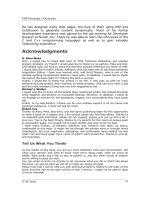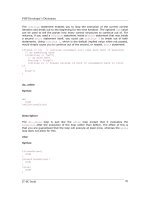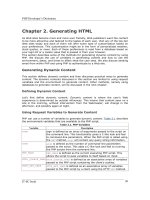PHP Developer''''s Dictionary- P11 docx
Bạn đang xem bản rút gọn của tài liệu. Xem và tải ngay bản đầy đủ của tài liệu tại đây (316.6 KB, 5 trang )
PHP Developer’s Dictionary
IT-SC book
50
pg_Close($conn);
?>
</body>
</html>
If the output of this script looks like this:
You have connected to the database successfully.
then congratulations—you have successfully connected to the test database.
Select, Insert, Update, and Delete Queries
You will routinely perform four types of queries when using any type of database.
The insert query will place items in the database, the update query will update
information that is already in the database, the select query will display information
in the database, and the delete query will delete items from the database. When you
query databases from inside PHP, you will allocate memory when a database
connection is made and when the result set is returned from your query. When your
script is finished executing, all memory will be freed, but it is good programming
practice to free the result by using the
pg_FreeResult()
function and to close the
connection by using the
pg_Close()
function.
Insert Queries
We will use the following example to insert information into our newly created
database. This example consists of two parts. The first part is a simple form that
enables the user to input specific information to be added to the database. This form
calls the PHP script that takes the form variables, and then creates and executes the
insert query. The HTML form looks like this:
<html>
<head>
<title>Insert Record</title>
</head>
<body>
<b>Please provide us with the following:</b></font>
<p><font size="2" face="Arial, Helvetica, sans-serif">
<form action="insert.php" method="POST" enablecab="Yes">
Full Name (Last, First MI):<br>
<input type="Text" name="FullName" align="LEFT"
required="Yes"
size="59" value=""><br>
Address:<br>
<input type="Text" name="Address" align="LEFT"
required="Yes"
size="59" value=""><br>
City:<br>
<input type="Text" name="City" align="LEFT" required="Yes"
size="29" value=""><br>
State:<br>
<input type="Text" name="State" align="LEFT" required="Yes"
PHP Developer’s Dictionary
IT-SC book
51
size="2" value=""><br>
Zip:<br>
<input type="Text" name="Zip" align="LEFT" required="Yes"
size="10" value=""><br>
Phone:<br>
<input type="Text" name="Phone" align="LEFT" required="No"
size="25" value=""><br>
Fax:<br>
<input type="Text" name="Fax" align="LEFT" required="Yes"
size="25" value=""><br>
Email:<br>
<input type="Text" name="Email" align="LEFT"
required="Yes"
size="59" value=""><br>
<input type="Submit" name="Submit" value="Submit"
align="MIDDLE">
</form>
</body>
</html>
Notice that the form variables in the example are
FullName
,
Address
,
City
,
State
,
Zip
,
Phone
,
Fax
, and
. The PHP script, which is named insert.php, refers to
these posted form variables as
$FirstName
,
$Address
,
$City
,
$State
,
$Zip
,
$Phone
,
$Fax
, and
. The PHP script looks like this:
<html>
<head>
<title>Insert the Form Data</title>
</head>
<body>
<?
// Connect to the Postgres Database
$conn = pg_Connect("localhost", "5432", "", "", "test");
if (!$conn) { echo "An database connection error occurred.\ n";
exit;}
// Insert the form values into the database
$result = pg_Exec($conn,"INSERT INTO contacts VALUES
(NEXTVAL('c'),'$FullName','$Address','$City','$State','$Zip',
'$Phone','$Fax','$Email');");
if (!$result) { echo "An INSERT query error occurred.\ n"; exit;}
// Get the last record inserted
$oid = pg_getlastoid($result);
if (!$oid) { echo "An OID error occurred.\ n"; exit;}
// Select the record that was last entered
$result = pg_Exec($conn,"SELECT cid FROM contacts WHERE oid=$oid;");
if (!$result) { echo "A SELECT query error occurred.\ n"; exit;}
// Place the result into the variable $CID
$CID = pg_Result($result, 0, "cid");
if (!$CID) { echo "There is a problem returning the Contact ID.\ n";
exit;}
// Print out the Contact ID
else { echo "The record was successfully entered and the Contact ID
is:
$CID \n";}
// Free the result
PHP Developer’s Dictionary
IT-SC book
52
pg_FreeResult($result);
// Close the connection
pg_Close($conn);
?>
</body>
</html>
The code for this example first inserts the information from the form into the
database and then uses the
pg_getlastoid()
function to get the last record
entered. It then uses the retrieved object identifier (OID) to query the database, and
returns the customer identifier (CID) of the last record. If all goes well, the contact
ID is printed to the browser window. The last part of this example is not needed to
insert records using PHP, but it is included to illustrate the use of the
pg_getlastoid()
function.
Select Queries with PHP
We gave you a taste of a select query in the previous section. This section takes the
result set from the select query and formats it for presentation in a Web page. The
select query often displays information that you would like to either change or
delete. Notice in the following example that edit and delete links are included. We
will create these pages later in this chapter. For now, let's look at this example:
<html>
<head>
<title>Select Query</title>
<?
$conn = pg_Connect("localhost", "5432", "", "", "test");
if (!$conn) { echo "An database connection error occurred.\ n";
exit;}
$result = pg_Exec($conn,"SELECT cid, name, address, city, state, zip,
phone,
fax, email FROM contacts ORDER BY name");
if (!$result) { echo "A query error occurred.\ n"; exit;}
$ContactNum = pg_NumRows($result);
$i = 0;
while ($i < $ContactNum) {
$CID[$i] = pg_Result($result, $i, "cid");
$CName[$i] = pg_Result($result, $i, "name");
$CAddress[$i] = pg_Result($result, $i, "address");
$CCity[$i] = pg_Result($result, $i, "city");
$CState[$i] = pg_Result($result, $i, "state");
$CZip[$i] = pg_Result($result, $i, "zip");
$CPhone[$i] = pg_Result($result, $i, "phone");
$CFax[$i] = pg_Result($result, $i, "fax");
$CEmail[$i] = pg_Result($result, $i, "email");
$i++;
}
pg_FreeResult($result);
pg_Close($conn);
?>
</head>
<body>
<table>
PHP Developer’s Dictionary
IT-SC book
53
<TR>
<TD></TD>
<TD><b>Full Name</b></TD>
<TD><b>Address</b></TD>
<TD><b>City</b></TD>
<TD><b>State</b></TD>
<TD><b>Zip</b></TD>
<TD><b>Phone</b></TD>
<TD><b>Fax</b></TD>
<TD><b>Email</b></TD>
</TR>
<?
$i = 0;
while ($i < $ContactNum) {
echo "<TR><TD><A
href=editform.php?ID=".$CID[$i].">[Edit]</A>";
echo "<A
href=delete.php?ID=".$CID[$i].">[Delete]</A></TD>";
echo "<TD>".$CName[$i]."</TD>";
echo "<TD>".$CAddress[$i]."</TD>";
echo "<TD>".$CCity[$i]."</TD>";
echo "<TD>".$CState[$i]."</TD>";
echo "<TD>".$CZip[$i]."</TD>";
echo "<TD>".$CPhone[$i]."</TD>";
echo "<TD>".$CFax[$i]."</TD>";
echo "<TD>".$CEmail[$i]."</TD></TR>";
$i++;
}
?>
</table>
</body>
</html>
The next section examines this example and explains how to work with the data that
is returned from the query.
Working with the Result Set
One of the main features of the preceding example is the use of an array to store the
items that are returned from the select query. The while loop uses the pg_Result()
function to get the records that are returned from the select query and stores them
in variables. These variables are used later in the script to present the information to
the Web browser. The
pg_NumRows()
function is used to return the number of
returned records and, therefore, the number of times that the
while
loop should be
executed to store all the returned information. Notice that a
while
loop is once again
used to step through the array and print the variables in the appropriate place in an
HTML table. The CID is used as an identifier in all the returned rows. After the edit
and delete links are completed, this identifier will be used in subsequent queries to
keep track of the record.
Update Queries
PHP Developer’s Dictionary
IT-SC book
54
This section continues with the example that was started with the select query. After
you click on the Edit hyperlink on the Select Query page, the CID is passed to the
Edit Record page. The code listing for this page follows:
<html>
<head>
<title>Edit Record Form</title>
<?
$conn = pg_Connect("localhost", "5432", "", "", "test");
if (!$conn) { echo "An database connection error occurred.\ n";
exit;}
$result = pg_Exec($conn,"SELECT cid, name, address, city, state, zip,
phone, fax, email FROM contacts WHERE cid = $ID");
if (!$result) { echo "A query error occurred.\ n"; exit;}
$CID = pg_Result($result, $i, "cid");
$CName = pg_Result($result, $i, "name");
$CAddress = pg_Result($result, $i, "address");
$CCity = pg_Result($result, $i, "city");
$CState = pg_Result($result, $i, "state");
$CZip = pg_Result($result, $i, "zip");
$CPhone = pg_Result($result, $i, "phone");
$CFax = pg_Result($result, $i, "fax");
$CEmail = pg_Result($result, $i, "email");
pg_FreeResult($result);
pg_Close($conn);
?>
</head>
<body>
<b>Please update the following:</b></font>
<p><font size="2" face="Arial, Helvetica, sans-serif">
<form action="edit.php?ID=<? echo $CID ?>" method="POST"
enablecab="Yes">
Full Name (Last, First MI):<br>
<input type="Text" name="FullName" align="LEFT" required="Yes"
size="59"
value="<? echo $CName ?>"><br>
Address:<br>
<input type="Text" name="Address" align="LEFT" required="Yes"
size="59"
value="<? echo $CAddress ?>"><br>
City:<br>
<input type="Text" name="City" align="LEFT" required="Yes" size="29"
value="<? echo $CCity ?>"><br>
State:<br>
<input type="Text" name="State" align="LEFT" required="Yes" size="2"
value="<? echo $CState ?>"><br>
Zip:<br>
<input type="Text" name="Zip" align="LEFT" required="Yes" size="10"
value="<? echo $CZip ?>"><br>
Phone:<br>
<input type="Text" name="Phone" align="LEFT" required="No" size="25"









